Crack-Bridging Property Evaluation of Synthetic Polymerized Rubber Gel (SPRG) through Yield Stress Parameter Identification
Abstract
:1. Introduction
2. Objectives
2.1. Non-Newtonian Fluids and Viscoelastic Properties of GILRM Materials
2.2. Modulus of Toughness vs. Adhesion Strength against Water Pressure as a Means of Deriving an Evaluation Criteria for Viscoelastic GILRM
- p = pressure in liquid (g/mm2, N/mm2),
- w = unit weight of water (g/mm3),
- h = depth of water (mm).
3. Materials and Methods
4. Results
4.1. Adhesive Strength Test Results Comparison for Four Types of GILRM
4.2. Adhesive Strength Test Results Comparison for SPRG Types (by Mixture Ratio)
4.2.1. Stress-Strain Curves Analysis of SPRG
4.2.2. Yield Stress Derivation of SPRG (Tentative Results)
- a.
- Viscoelastic material property section (Viscoelastic section): this section is compliant to conventional viscoelastic material that resists the application of external energy in the entangled state in which the coil state is maintained similar to an intermolecular skein between the crosslinking points. This section is comprised of the conventional creep property of viscoelastic materials and tensile stress application (a and b of Figure 7)
- b.
- Tensile stress application section (Tensile stress start): The crosslinking point and the intermolecular entanglement state are converted to an unwinding state as they are stretched by an external force, but a region in which deformation occurs constantly by resisting external force only with cohesive force.
- c.
- Tensile stress resistance section (SPRG resistance section): The crosslinking point and the intermolecular entanglement state are converted to an unwinding state while being stretched by an external force, and the deformation occurs constantly while maintaining the minimum cohesive force by adapting to the external force. The intermolecular entanglement between bridge points is released against external forces that continue after the yield point, but the cohesive force is maintained in a state where the entanglement state is not broken. As the SPRG material enters this section during the stress strain curve, the material shows proportional elastic behavior and yield at the maximum point of cohesive force.
- d.
- Dashpot region according to Maxwell model (particle separation section): After the resistance section, the entangled force between molecules is lost due to external force, and the bond begins to completely unravel, and the phase changes and elongates. (However, the material attached to the surface to be adhered is maintained the same as the initial adhesion area)
- e.
- Elongation section: A section where the cohesive force converges to 0 while maintaining the minimum resistance due to entanglement between molecules and breaks at the point of maximum elongation.
4.3. Repeated Yield Stress Limit Test Result of SPRG (Tentative Results)
- UT = energy (Jmm−3, N/mm2)
- P = Force (N)
- A = Area (mm2)
- = Change in L (mm)
- L = Change in Length (mm)
- (unitless, (%) when considered as ratio)
- (MPa, N/mm2)
4.4. Possible Application of Proposed Evaluation Methodology (e.g., Finite Element Method Analysis)
5. Conclusions
- (1)
- A preliminary testing consisting of adhesive strength measurement testing of four types of GILRM (UR, ER, AR and SPRG) was conducted. Adhesive strength of the four GILRM appears in the order of AR < SPRG < UR < ER. A Stress-strain diagram for each GILRM specimen types based on the measurement results, whereby it was confirmed that the maximum elongation (strain ratio) rate was in the order of SPRG > AR > UR > ER. Comparison of the elongation rate warranted a further investigation into the SPRG material that has a viscoelastic property.
- (2)
- A secondary testing followed consisting of measuring the adhesive strength of 3 different types of SPRG, each with different rubber mixture component ratio. For each, a stress-strain diagram was obtained by the inflection point, and an overall stress-strain curve is used to propose a tentative representative yield stress curve for SPRG materials.
- (3)
- Lastly, a subsequent experiment by repeated tensile stress application was conducted to derive a sequential stress-strain curves, whereby toughness calculation allowed an assessment of whether the SPRG materials are able to maintain adequate durability against common levels of water pressure compliant to standards in Korea. An example application of durability assessment is proposed by an Abaqus based Finite element method analysis, where the modelling results show that the material is able to withstand a common level of hydrostatic pressure of up to 0.2 N/mm2. Varying ranges of hydrostatic pressure conditioning and material property changes can be applied to assess different types of SPRGs currently in the market.
Author Contributions
Funding
Institutional Review Board Statement
Informed Consent Statement
Data Availability Statement
Conflicts of Interest
References
- Oh, S.-K.; Shim, J.-S. Maintenance for leakage due to cracking in concrete structures—Guidelines for repair of water-leakage cracks in concrete structures. J. Korea Concr. Inst. 2011, 23, 47–52. [Google Scholar]
- Chang, S.J. Advanced technology of waterproofing. J. Arch. Inst. Korea 2005, 49, 57–60. [Google Scholar]
- Oh, S.K.; Lee, J.H.; Song, J.Y.; Kim, S.Y. A study on the construction detail of waterproofing in underground of apartments. J. Korea Inst. Build. Constr. 2017, 17, 215–216. [Google Scholar]
- International Organization for Standardization. ISO TR 16475: 2011 Guidelines for the Repair of Water-leakage Cracks in Concrete Structures; Technical Committee 71 Subcommittee 7; ISO: Geneva, Switzerland, 2011. [Google Scholar]
- International Organization for Standardization. ISO TS 16774: 2011 Parts 1–6, Guidelines for the Repair of Water-leakage Cracks in Concrete Structures; Technical Committee 71 Subcommittee 7; ISO: Geneva, Switzerland, 2017. [Google Scholar]
- Mohamed, A.S.; Zeinab, A.E.; Alaa, K. Evaluation of polyurethane resin injection for concrete leak repair. Case Stud. Constr. Mater. 2019, 11, e00307. [Google Scholar] [CrossRef]
- Kim, S.-Y.; Oh, S.-K.; Kim, B. Artificial-crack-behavior test evaluation of the water-leakage repair materials used for the repair of water-leakage cracks in concrete structures. Appl. Sci. 2016, 6, 253. [Google Scholar] [CrossRef] [Green Version]
- Jiang, B.; Oh, K.-H.; Kim, S.-Y.; He, X.; Oh, S.-K. Technical evaluation method for physical property changes due to environmental degradation of grout-injection repair materials for water-leakage cracks. Appl. Sci. 2019, 9, 1740. [Google Scholar] [CrossRef] [Green Version]
- RE-Systems Group Americas. Polymer Rubber Gel Systems. Waterproof Magazine. April 2014, pp. 26–29. Available online: https://www.waterproofmag.com/downloads/2014-04/WP_2014-04_Polymer_Rubber.pdf (accessed on 23 August 2021).
- Park, J.S.; Kim, D.B.; Park, W.G.; Oh, S.K. Analysis on the causes of the oil leakage phenomenon for complex waterproofing methods of asphalt mastic and modified asphalt sheet. J. Korea Inst. Build. Constr. 2018, 18, 337–345. [Google Scholar]
- Dariusz, S. Non-Newtonian viscosity of polymer-modified bitumens. Mater. Struct. 1993, 26, 15–23. [Google Scholar] [CrossRef]
- Zhu, H.; Kim, Y.D.; Kee, D.D. Non-Newtonian fluids with a yield stress. J. Non Newton. Fluid Mech. 2005, 129, 177–181. [Google Scholar] [CrossRef]
- Palade, L.; Attane, P.; Camaro, S. Linear viscoeslastic behavior of asphalt and asphalt based mastic. Rheologica Acta 2000, 39, 180–190. [Google Scholar] [CrossRef]
- Long, Y.; Dabros, T.; Hamza, H. Stability and settling characteristics of solvent-diluted bitumen emulsions. Fuel 2002, 81, 1945–1952. [Google Scholar] [CrossRef]
- Ahn, D.-S. A Study on the Physical Properties Change of Synthetic Rubber Polymer Gel by Using Stirring Screw Mixer. Master’s Thesis, Seoul National University of Science and Technology, Seoul, Korea, 2015. [Google Scholar]
- Oh, S.K.; Seo, S.J.; Park, J.S.; Kim, D.B.; Choi, S.Y.; Kim, B.I. A study on compatibility between asphalt mastic and poly urethane coating material (focused on fatigue resistance). J. Korea Inst. Build. Constr. 2018, 18, 255–256. [Google Scholar]
- Oh, S.-K.; Lee, J.-H.; Choi, S.-M. An experimental study on the highly adhesive composite waterproofing sheet using reclaimed rubber. J. Archit. Inst. Korea 2014, 16, 279–284. [Google Scholar]
- Seo, W.I.; Kim, S.Y.; Kwak, G.S.; Oh, S.G. A Study on Complex Waterproofing Method Using Part of Joint Water-Tightness Improved Sheet; The Korea Institute of Building Construction: Seoul, Korea, 2004; Volume 7, pp. 1–6. [Google Scholar]
- Sarnowski, M.; Radziszewski, P.; Kowalski, K.K. Impact of high process temperature on viscoelastic properties of polymer modified bitumen in waterproofing and bridge pavements. In Proceedings of the 3rd International Conference on Road and Rail Infrastructure (CETRA), Split, Croatia, 28–30 April 2014. [Google Scholar]
- Deckard, C.; Hagerty, P.D. Rethinking waterproofing for subsurface structures. In Forensic Engineering 2009: Pathology of the Built Environment, 1st ed.; Chen, S.-E., de Leon, A.D., Dolhon, A.M., Drerup, M.J., Parfitt, M.K., Eds.; American Society of Civil Engineers (ASCE): Washington, DC, USA, 2009; pp. 298–307. [Google Scholar]
- Oba, K.; Hugener, M. Characterization of polymer modified bituminous roofing membranes using chromatography. Mater. Struct. 1995, 28, 534–544. [Google Scholar] [CrossRef]
- Zakari, N.; Muhammad-Keyvanfar, A.; Muhd-Zaimi-Abd, M.; Shafaghat, A.; Mirza, J. Waterproof performance of concrete: A critical review on implemented approaches. Constr. Build. Mater. 2015, 101, 80–90. [Google Scholar]
- Im, C.J. Waterproofing Performance Tests for a Composite Waterproofing Method of Asphalt Mastic Film and Sheet; DONG-EUI Institute of Technology: Busan, Korea, 2000; Volume 26, pp. 53–62. [Google Scholar]
- Elistratkin, M.Y.; Lesovik, V.S.; Zagorodnjuk, L.H. New point of view on materials development. In IOP Conference Series: Materials Science and Engineering; IOP Publishing: Bristol, UK, 2018; Volume 327, p. 032020. [Google Scholar] [CrossRef] [Green Version]
- Public Housing Project Office. Establishment of Measures to Improve Quality of House Waterproofing Methods for Zero Defects in Quality Management; Korea Land & Housing Corporation: Jinju-si, Korea, 2017; pp. 1–3. [Google Scholar]
- Cuadri, A.A.; Carrera, V.; Izquierdo, M.A.; García-Morales, M.; Navarro, F.J. Bitumen modifiers for reduced temperature bitumens: A comparative analysis between three polymeric and non-polymeric additives. Constr. Build. Mater. 2014, 51, 82–88. [Google Scholar] [CrossRef] [Green Version]
- Isacsson, U. A compilation of laboratory methods for studying stability of bitumen emulsions. Mater. Struct. 1985, 18, 228–236. [Google Scholar] [CrossRef]
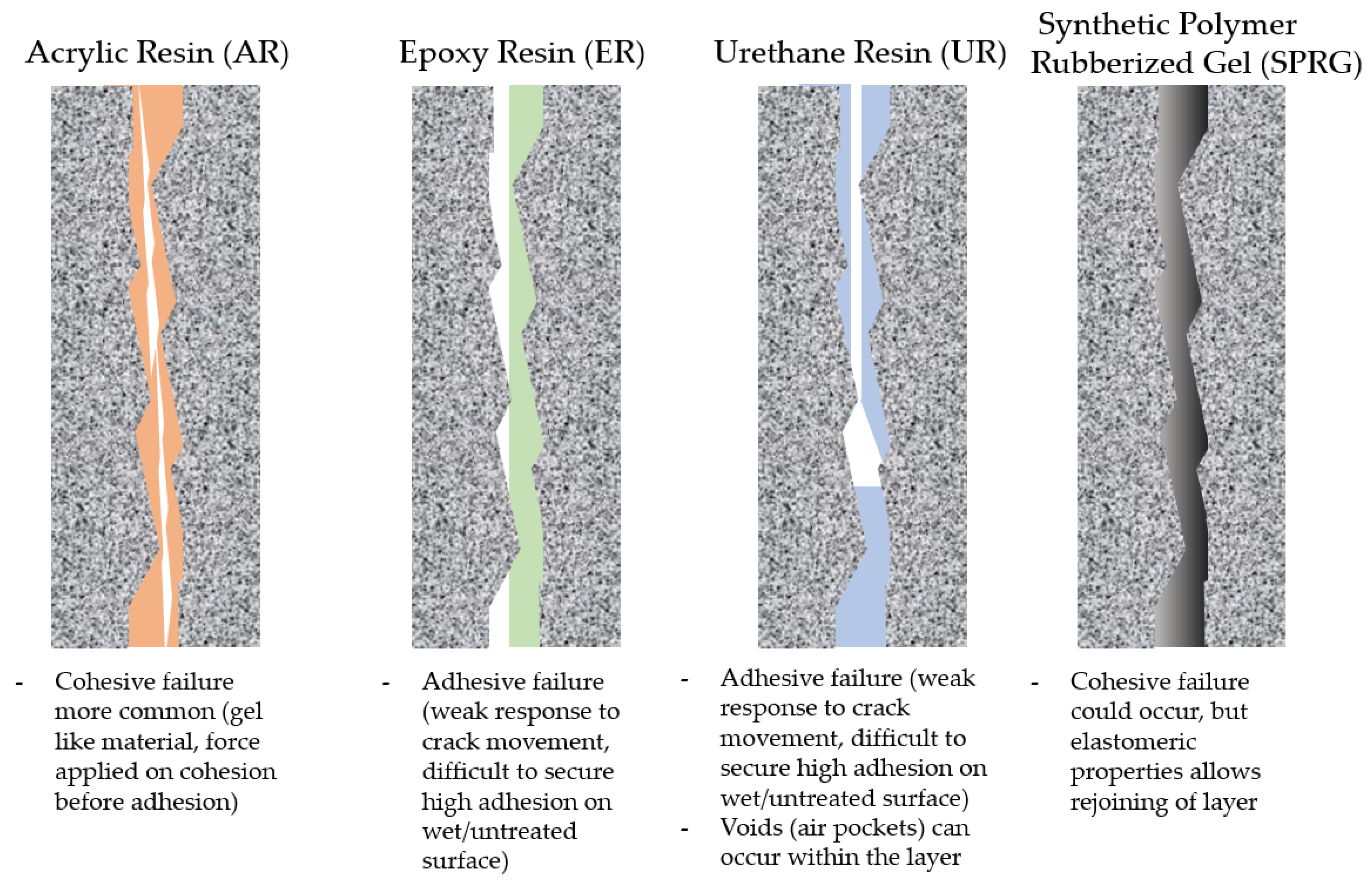
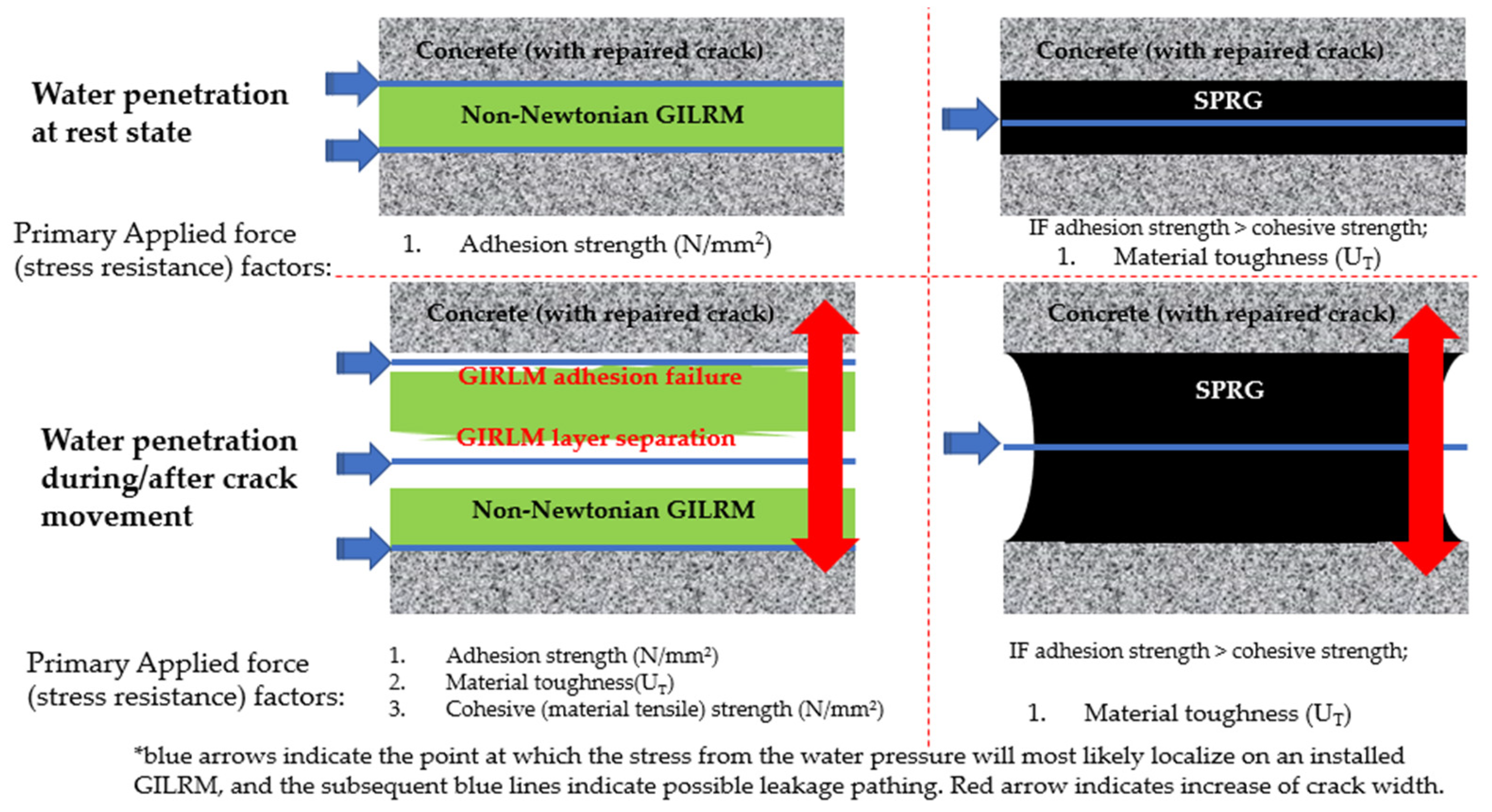
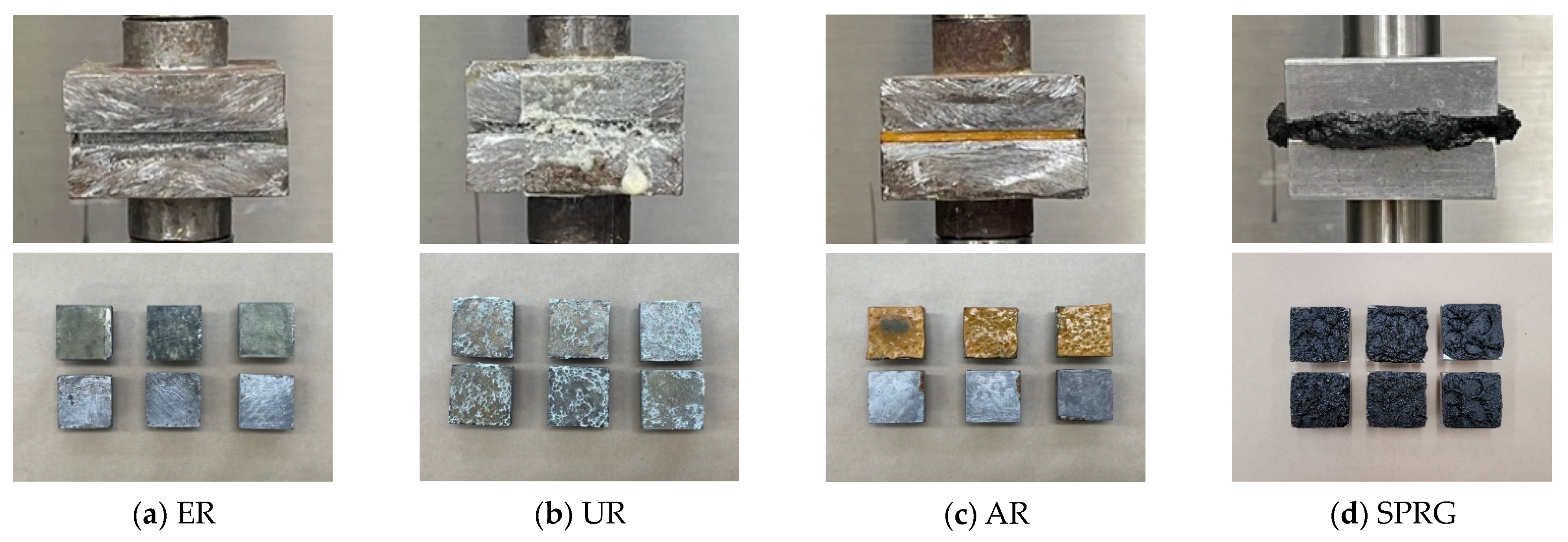
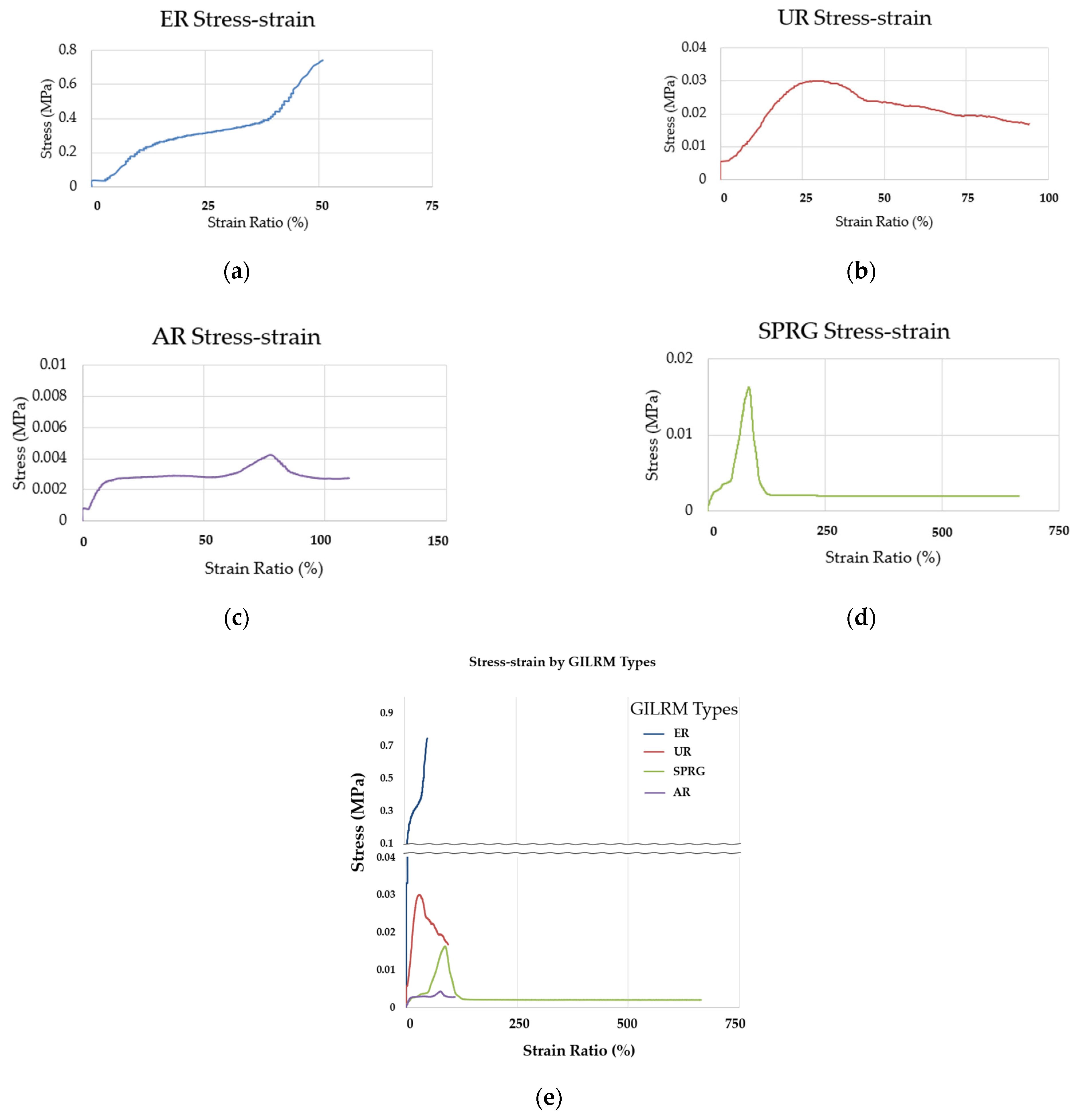
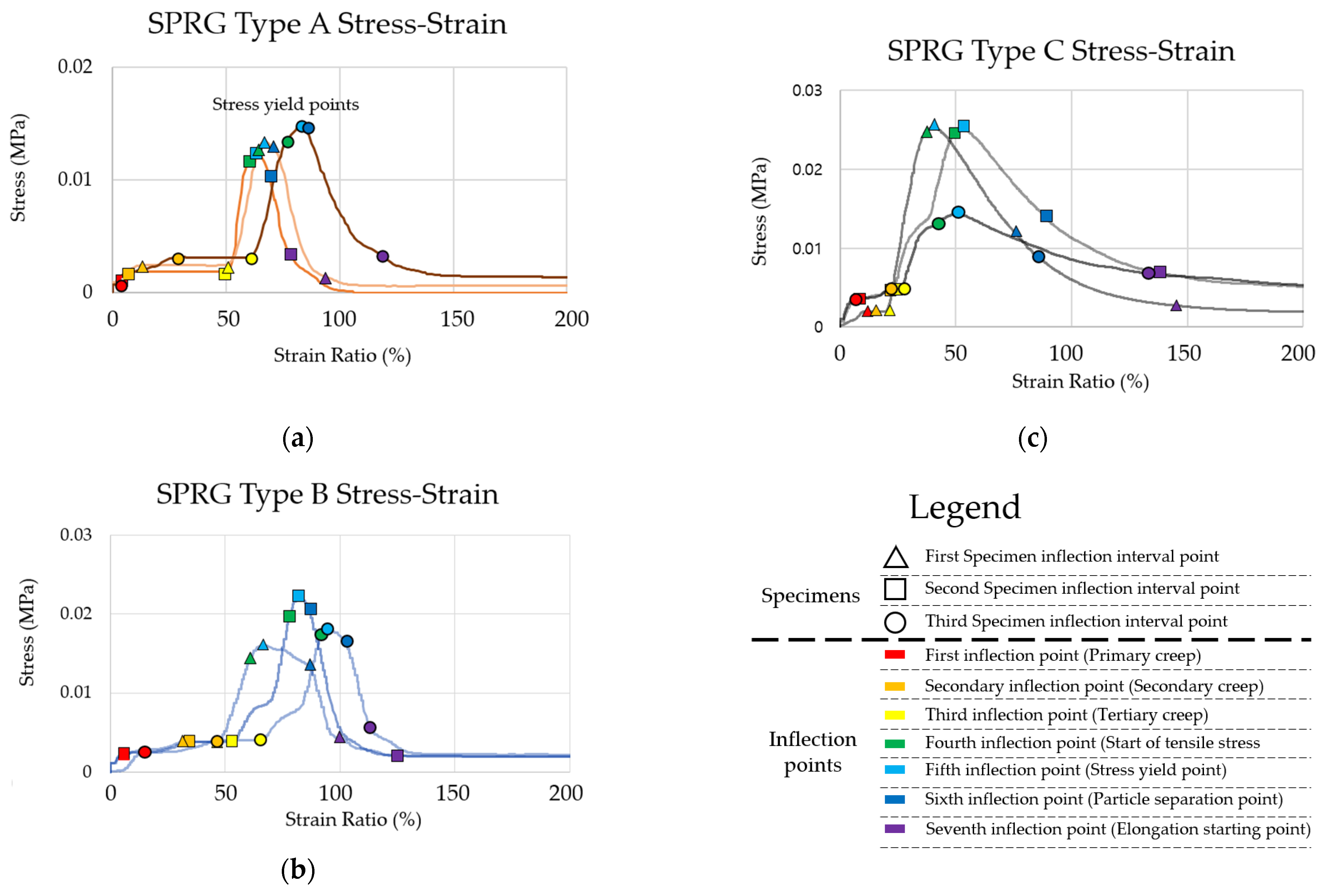

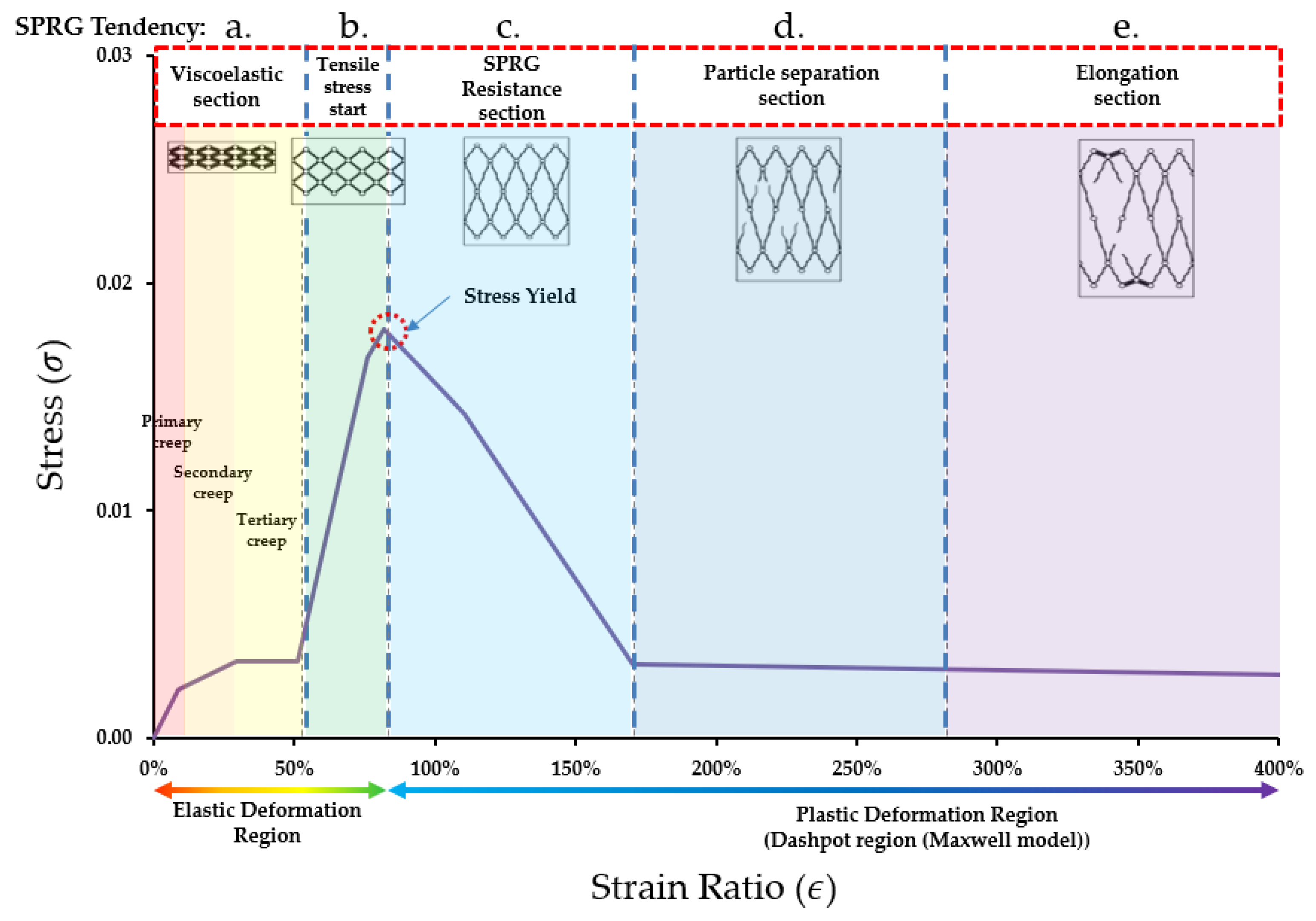


| Material Type | Composition | Basic Properties |
|---|---|---|
| Epoxy Resin (ER) | Epoxy Resin (2): Polyamine (1) |
|
| Urethane Resin (UR) | Polyurethane resin and other additives |
|
| Acrylic Resin (AR) | Sodium polyacrylate, acrylamide-sodium acrylate, Water, hardener (sulfate compound, water), catalyst (triethanolamine, water) |
|
| Synthetic-polymerized Rubber Gel (SPRG) | Waste rubber, waste oil, tackifier, asphalt, asphalt modifier, filler, etc. |
|
| Properties | Type A | Type B | Type C | |
|---|---|---|---|---|
| Composition | Waste oil | 24% | 22.5% | 20% |
| Waste rubber | 6% | 7.5% | 10% | |
| Asphalt | 35% | |||
| Tackifier | 10% | |||
| Asphalt modifier | 5% | |||
| Filler | 20% | |||
| Total | 100% | |||
| Viscosity | 1,800,000 cp | 3,500,000 cp | 5,000,000 cp | |
| GILRM Materials | EP | UR | AR | SPRG |
|---|---|---|---|---|
| Adhesive strength (MPa) | 0.6537 | 0.0381 | 0.0048 | 0.0162 |
| Strain at failure (adhesive or cohesive) (%) | 51 | 94 | 97 | 664 |
| Type | Specimen # | Adhesive Strength (N/mm2) | Elongation Strain (%) | ||
|---|---|---|---|---|---|
| Type A | 1 | 0.0125 | 0.0136 | 106 | 695 |
| 2 | 0.0134 | 849 | |||
| 3 | 0.0148 | 1129 | |||
| Type B | 1 | 0.0220 | 0.0186 | 804 | 811 |
| 2 | 0.0179 | 959 | |||
| 3 | 0.0160 | 671 | |||
| Type C | 1 | 0.0251 | 0.0216 | 1881 | 1667 |
| 2 | 0.0143 | 1817 | |||
| 3 | 0.0253 | 1304 | |||
| Avg. | 0.0164 | 1098 | |||
| Yield Stress Point Sections | Type A | Type B | Type C | |||||||
|---|---|---|---|---|---|---|---|---|---|---|
| 1 (Triangle) | 2 (Circle) | 3 (Square) | 1 (Triangle) | 2 (Circle) | 3 (Square) | 1 (Triangle) | 2 (Circle) | 3 (Square) | ||
| Stress (MPa) | ||||||||||
| Inflection Points | Start | 0 | 0 | 0 | 0 | 0 | 0 | 0 | 0 | 0 |
| 1 | 0.0012 | 0.0009 | 0.0008 | 0.0023 | 0.0025 | 0.0022 | 0.0034 | 0.0034 | 0.0019 | |
| 2 | 0.0018 | 0.0008 | 0.0031 | 0.0038 | 0.0038 | 0.0038 | 0.0045 | 0.0047 | 0.0020 | |
| 3 | 0.0018 | 0.0024 | 0.0031 | 0.0038 | 0.0040 | 0.0038 | 0.0046 | 0.0047 | 0.0020 | |
| 4 | 0.0117 | 0.0128 | 0.0134 | 0.0195 | 0.0171 | 0.0142 | 0.0242 | 0.0129 | 0.0244 | |
| 5 | 0.0125 | 0.0134 | 0.0148 | 0.0220 | 0.0179 | 0.0160 | 0.0251 | 0.0143 | 0.0253 | |
| 6 | 0.0104 | 0.0130 | 0.0146 | 0.0216 | 0.0175 | 0.0158 | 0.0245 | 0.0127 | 0.0251 | |
| 7 | 0.0035 | 0.0014 | 0.0015 | 0.0021 | 0.0023 | 0.0020 | 0.0054 | 0.0062 | 0.0019 | |
| After | 0.0001 | 0.0005 | 0.0012 | 0.0019 | 0.0021 | 0.0019 | 0.0025 | 0.0027 | 0.0000 | |
| Strain Ratio (%) | ||||||||||
| Inflection Points | Start | 0 | 0 | 0 | 0 | 0 | 0 | 0 | 0 | 0 |
| 1 | 3 | 3 | 3 | 6 | 15 | 6 | 13 | 10 | 20 | |
| 2 | 6 | 12 | 28 | 35 | 47 | 32 | 40 | 41 | 28 | |
| 3 | 49 | 50 | 61 | 53 | 66 | 47 | 46 | 53 | 40 | |
| 4 | 60 | 64 | 77 | 78 | 92 | 61 | 97 | 83 | 73 | |
| 5 | 63 | 66 | 83 | 82 | 95 | 67 | 105 | 100 | 79 | |
| 6 | 69 | 70 | 86 | 85 | 99 | 70 | 113 | 128 | 85 | |
| 7 | 78 | 93 | 146 | 125 | 131 | 123 | 346 | 327 | 379 | |
| After | 106 | 849 | 1129 | 156 | 959 | 671 | 1881 | 1817 | 1304 | |
| Yield Stress Point Sections | Type A | Type B | Type C | Types A,B,C Avg. | ||||
|---|---|---|---|---|---|---|---|---|
| Stress (N/mm2) | Strain (%) | Stress (N/mm2) | Strain (%) | Stress (N/mm2) | Strain (%) | Stress (N/mm2) | Strain (%) | |
| Start | 0.0000 | 0 | 0.0000 | 0 | 0.0000 | 0 | 0.0000 | 0 |
| 1 | 0.0010 | 3 | 0.0023 | 9 | 0.0029 | 14 | 0.0026 | 15 |
| 2 | 0.0019 | 15 | 0.0038 | 38 | 0.0037 | 36 | 0.0033 | 34 |
| 3 | 0.0024 | 53 | 0.0039 | 55 | 0.0038 | 46 | 0.0034 | 46 |
| 4 | 0.0126 | 67 | 0.0169 | 77 | 0.0205 | 84 | 0.0186 | 78 |
| 5 | 0.0136 | 70 | 0.0186 | 81 | 0.0216 | 95 | 0.0198 | 90 |
| 6 | 0.0127 | 75 | 0.0183 | 85 | 0.0207 | 108 | 0.0189 | 106 |
| 7 | 0.0021 | 105 | 0.0021 | 126 | 0.0045 | 351 | 0.0040 | 353 |
| Yield stress Point | 0.0006 | 695 | 0.0020 | 811 | 0.0017 | 1667 | 0.0014 | 1560 |
| Conditions | Toughness Per Specimen (N/mm2) | ||||||||||||
|---|---|---|---|---|---|---|---|---|---|---|---|---|---|
| SPRG Types | Type A | Type B | Type C | ||||||||||
| Specimen Number | 1 | 2 | 3 | Average | 1 | 2 | 3 | Average | 1 | 2 | 3 | Average | |
| StressPer Cycle | InitialToughness | 88.7 | 75.7 | 63.5 | 76.0 | 248.1 | 207.5 | 292.1 | 249.2 | 1462.6 | 1707.5 | 1220.6 | 1463.6 |
| 1st Cycle | 63.5 | 54.2 | 45.5 | 54.4 | 186.5 | 156.0 | 219.7 | 187.4 | 275.6 | 321.8 | 230.0 | 275.8 | |
| 2nd Cycle | 61.9 | 52.8 | 44.4 | 53.0 | 183.4 | 153.4 | 216.0 | 184.3 | 269.5 | 314.6 | 224.9 | 269.7 | |
| 3rd Cycle | 61.3 | 53.1 | 44.2 | 52.9 | 177.5 | 148.5 | 209.0 | 178.3 | 271.5 | 317.0 | 226.6 | 271.7 | |
| 4th Cycle | 60.9 | 52.0 | 43.7 | 52.2 | 171.9 | 143.8 | 202.4 | 172.7 | 268.1 | 312.9 | 223.7 | 268.2 | |
| Average | 61.9 | 53.0 | 44.5 | 53.1 | 179.8 | 150.4 | 211.8 | 180.7 | 271.2 | 316.6 | 226.3 | 271.4 | |
Publisher’s Note: MDPI stays neutral with regard to jurisdictional claims in published maps and institutional affiliations. |
© 2021 by the authors. Licensee MDPI, Basel, Switzerland. This article is an open access article distributed under the terms and conditions of the Creative Commons Attribution (CC BY) license (https://creativecommons.org/licenses/by/4.0/).
Share and Cite
Lee, J.-Y.; Seo, H.-J.; Oh, K.-H.; Bo, J.; Oh, S.-K. Crack-Bridging Property Evaluation of Synthetic Polymerized Rubber Gel (SPRG) through Yield Stress Parameter Identification. Materials 2021, 14, 7599. https://doi.org/10.3390/ma14247599
Lee J-Y, Seo H-J, Oh K-H, Bo J, Oh S-K. Crack-Bridging Property Evaluation of Synthetic Polymerized Rubber Gel (SPRG) through Yield Stress Parameter Identification. Materials. 2021; 14(24):7599. https://doi.org/10.3390/ma14247599
Chicago/Turabian StyleLee, Jong-Yong, Hyun-Jae Seo, Kyu-Hwan Oh, Jiang Bo, and Sang-Keun Oh. 2021. "Crack-Bridging Property Evaluation of Synthetic Polymerized Rubber Gel (SPRG) through Yield Stress Parameter Identification" Materials 14, no. 24: 7599. https://doi.org/10.3390/ma14247599
APA StyleLee, J.-Y., Seo, H.-J., Oh, K.-H., Bo, J., & Oh, S.-K. (2021). Crack-Bridging Property Evaluation of Synthetic Polymerized Rubber Gel (SPRG) through Yield Stress Parameter Identification. Materials, 14(24), 7599. https://doi.org/10.3390/ma14247599






